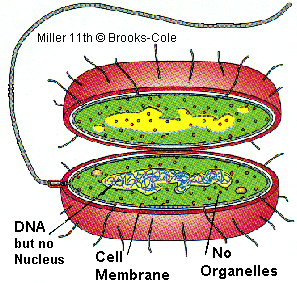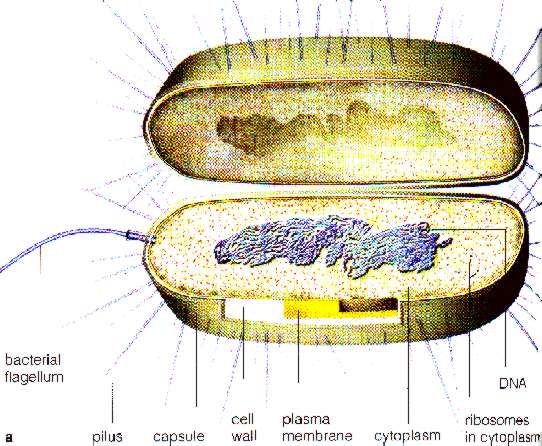|

http://library.thinkquest.org/C004535/prokaryotic_cells.html
Cells that lack a membrane-bound nucleus are called prokaryotes (from the Greek meaning before nuclei). These cells have few
internal structures that are distinguishable under a microscope. Cells in the monera kingdom such as bacteria and cyanobacteria
(also known as blue-green algae) are prokaryotes.
Prokaryotic Cells and Viruses
Prokaryotic cells are cells without a recognizable nucleus, such as bacteria and blue-green algae (now called cyanobacteria).
Instead of a nucleus these cells have a nucleoid which contains the DNA of the cell.
There continues to be debate over the status of viruses. Although they are regarded as "living" organisms, they
are non-cellular particles made up of a protein coat surrounding a nucleic acid core.
A scanning electron microscope (SEM) image of four yeast cells (these are eukaryotic, NOT prokaryotic cells) surrounded
by many rod-shaped bacteria (prokaryotic cells), some of which are dividing.
Bacteria (dividing) prepared by "negative staining" and imaged in the transmission electron microscope (TEM).
The technique is known as negative staining because the bacteria appear light against a dark background.
For more information about negative staining go to: http://www.ru.ac.za/emu/micr301.htm
Spherical virus particles viewed in the transmission electron microscope after negative staining. Some detail of the virus's
capsid structure and arrangement is visible. Magnification is about 200 000x (actual magnification depends on your monitor
size and resolution settings).
Click here for the next page: "the animal cell" Other pages
basic principles of microscopy for biologists
the animal cell
the plant cell
some important cell organelles
some specialised cells
further reading and useful web links
Click here to return to the Rhodes University EM Unit's Home Page. Edit Text
Prokaryotic cells differ significantly from eukaryotic cells. They don't have a membrane-bound nucleus and instead of
having chromosomal DNA, their genetic information is in a circular loop called a plasmid. Bacterial cells are very small,
roughly the size of an animal mitochondrion (about 1-2Ám in diameter and 10 Ám long). Prokaryotic cells feature three major
shapes: rod shaped, spherical, and spiral. Instead of going through elaborate replication processes like eukaryotes, bacterial
cells divide by binary fission. Bacteria perform many important functions on earth. They serve as decomposers, agents of fermentation,
and play an important role in our own digestive system. Also, bacteria are involved in many nutrient cycles such as the nitrogen
cycle, which restores nitrate into the soil for plants. Unlike eukaryotic cells that depend on oxygen for their metabolism,
prokaryotic cells enjoy a diverse array of metabolic functions. For example, some bacteria use sulfur instead of oxygen in
their metabolism.
Examples of Prokaryotic Cells

http://www.cod.edu/people/faculty/fancher/ProkEuk.htm
http://www.cod.edu/people/faculty/fancher/ProkEuk.htm
http://library.thinkquest.org/C004535/prokaryotic_cells.html
|

